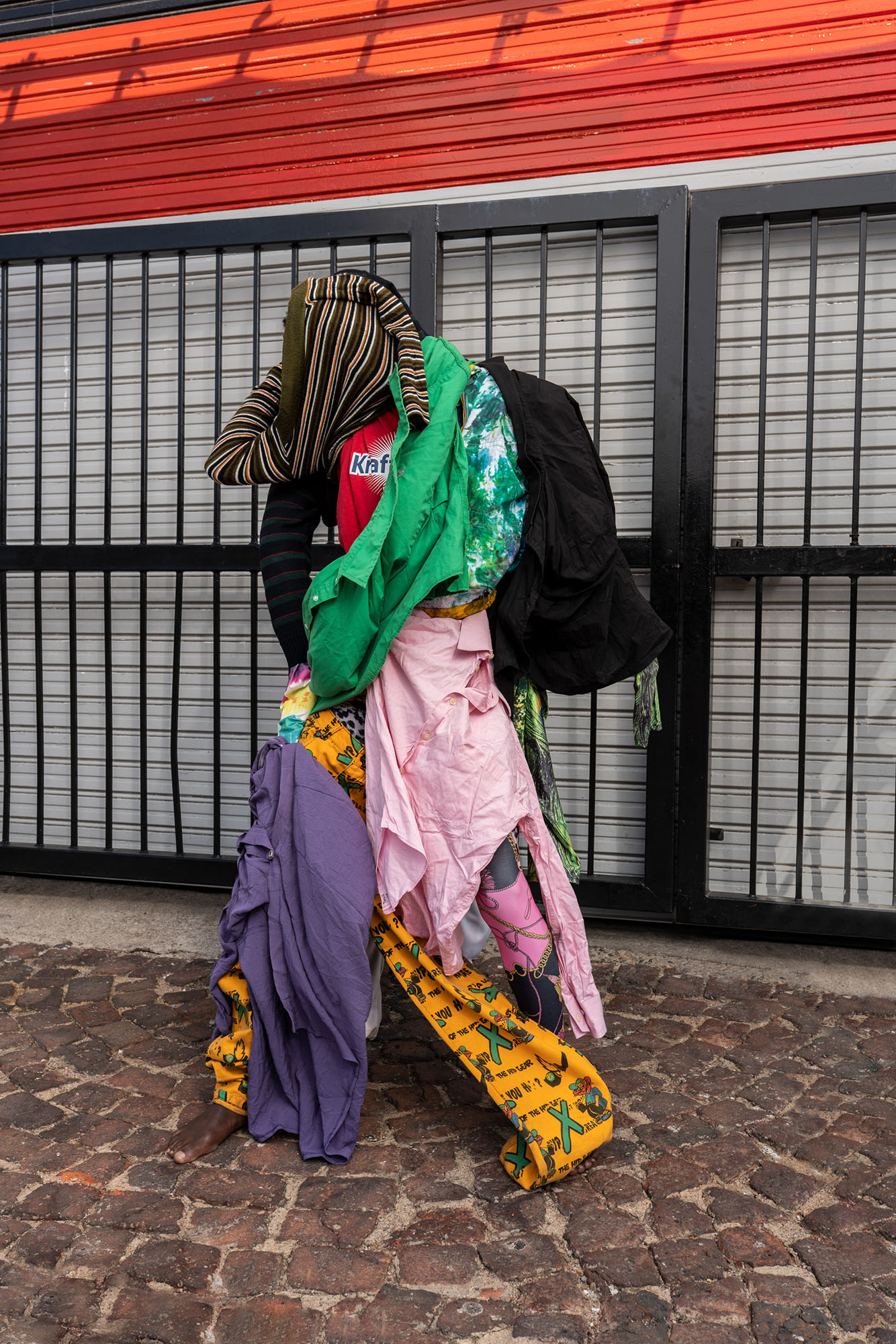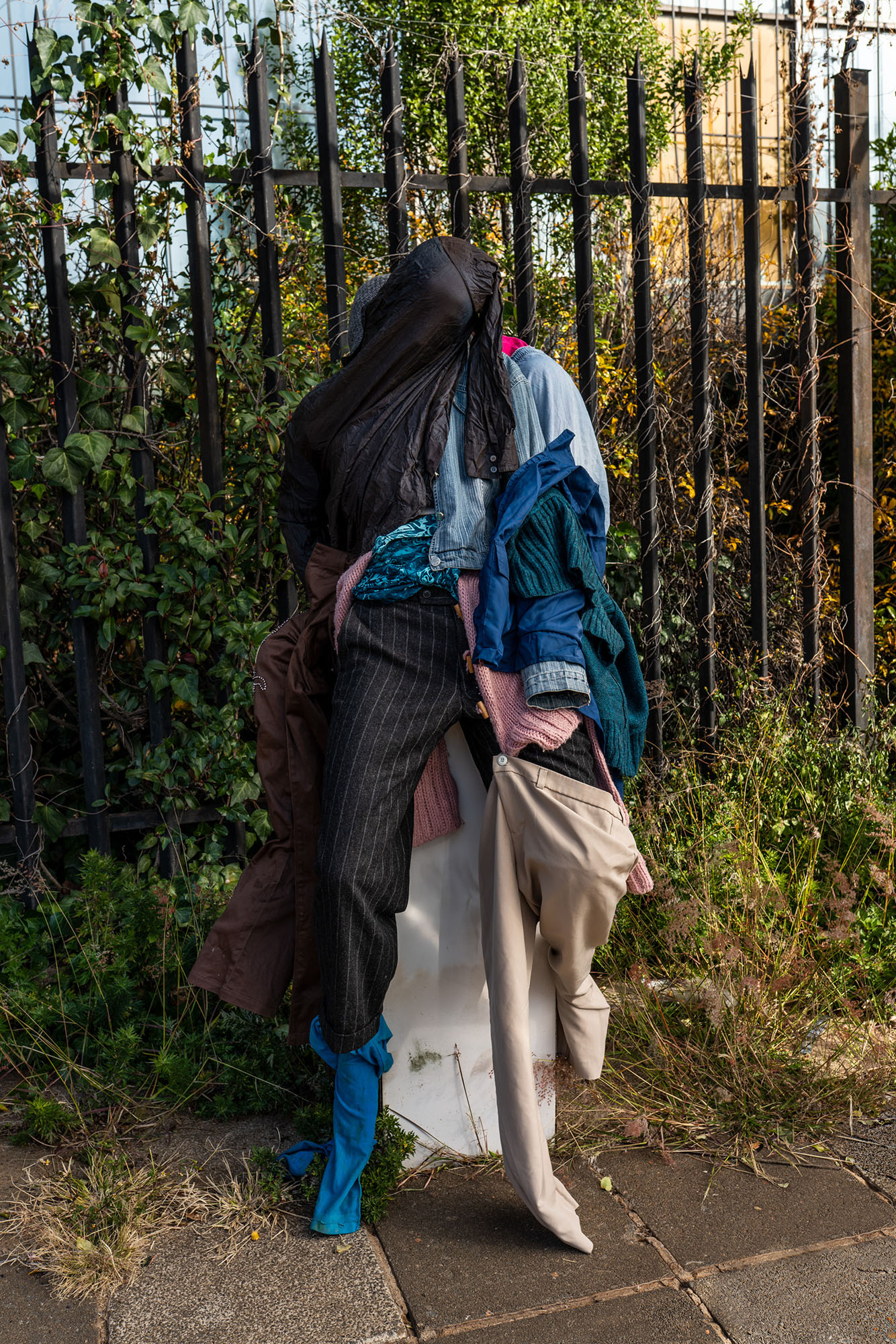






Made in Joburg
Jamal Nxedlana’s new body of work, Made in Joburg, takes this site as one of many cues for curiosity to travel across scales of time and space, using fashion as an interscalar vehicle[1] to survey the aesthetics and materiality of desire, identity expressions, consumerism, and subcultures. Produced on site at this landfill and other mine dumps across Johannesburg, his still and moving images invite consideration of the symbols and codes embedded not only in dress and performance, but also the global logistics, labour dynamics and class concerns often obscured from view when we talk about fashion. A previous series, #0047bb (named for the colour against which the models were shot), hinted at some of these concerns, bringing together human bodies and generic objects such as an off-the-shelf photo frame, blank T-shirt, and "African mask" sold at a furniture store to comment on the entanglements of industrial design, consumption, and complicity in the many vectors of contemporary capitalism. The skilful positioning and capturing of models’ luminosity against generic white T-shirts and ubiquitous white plastic chairs are a representational riposte against conventional (read: violent, exoticized, poorly lit) depictions of Black masculinity and associated commodification of race and gender.
In his latest series, Nxedlana turns his attention more critically to the circular economy and fashion cycles, cheaply manufactured clothing from China and used clothing from Europe arriving on cargo ships and freighted across the country until they are dumped in Dunusa[2], Joburg CBD’s massive open-air thrifting mecca. Nxedlana sourced most of the garments used in his previous work from Dunusa. This is not the only thrifting market in the city, nor is this the end of the journey for these clothing items, objects with their own temporalities of social life that themselves represent knots of social practice and cultural knowledge[3]. Multilevel informal livelihood generation means that used-clothing buyers are often also simultaneously sellers who plan to ply their trade in more lucrative markets: online, at gentrified markets in the city’s wealthier northern suburbs as well as in rural and township markets. But what is desirable is more than just bounty to resell or the allure of happening upon a coveted designer label; it is the promise of participation in the social capital gamut that both thrifting and fashion more broadly represents. This occurs in a social context of growing class consciousness in pop culture as traditional institutions like universities fail to deliver the social mobility historically promised to young people. Nxedlana’s critical attention to the fashion industry's maintenance of a pervasively unequal status quo is important as these concerns are not particular to Johannesburg, or even South Africa. Used-clothing imports to Africa have increased in tandem with the decline of African clothing industries since the implementation of economic liberalisation policies in the early 1980s. But while challenges experienced by African clothing industries have been well documented, the same is not true for explorations of the used clothing market.
Here, Nxedlana’s attention to associated cultural and economic trends calls attention to what lies beneath the proliferation of used clothing markets: from the glut of cheap goods imported from wealthy western countries and the decline in local purchasing power to the significant influence of globalised sustainability and slow fashion narratives influencing the desirability of ‘pre-loved’ goods, despite the identified inaccessibility of these outside of niche markets[4]. He directs our view to hidden tactics used to sell clothing, and the ways in which garments secretly condense narratives of desirability. In nuanced ways, he questions not only what guides desirability, but also legality and materiality. The bales of tightly wrapped clothing deposited at Joburg markets can be thought of as illegally dumped waste, given that many official trade data sets often fail to capture the nuances of the used clothing market[5]. Networks of labour, consumption, sociality, and class performance coalesce around these individual items and markets.
Nxedlana carefully unravels these processes, parsing through them just as carefully as the sacred ibis at the landfill, as carefully as he manually unpicked the ready-to-wear labels from found designer, middle-market and fast fashion garments and applied them to his actors[6], collating visuals from sites as diverse as Robinson Deep and Small Street Mall in the Joburg CBD. Using fashion as the prism through which to refract his interests, Nxedlana fixes his gaze on the still-festering wounds of colonial extraction, neoliberal exploitation and post-apartheid disappointment while still cultivating the thrilling excitement of urban subcultures, luxury consumption and creation. This brings to mind Mehita Iqani’s multifaceted research into how artists working with waste explore new forms of value creation through the potentiality of rubbish; and the aesthetics of cultural labour of South African influencers who market luxury brands on their Instagram profiles[7]. But Nxedlana’s work also recalls Homi Bhabha’s exploration of hybridity and the productive ambivalence of cultural production in postcolonial contexts[8]. According to Elizabeth Wilson, “fashion— as performance art — acts as a vehicle for this ambivalence; the daring of fashion speaks dread as well as desire.”[9]
For Nxedlana, hybridisations made in Joburg, brought to Joburg, or even inspired by Joburg are one way to explore the city’s mythologies and accrued sediments of cultures past and subcultures yet to emerge. His work traverses both the neon flowers[10] and brittle honeycomb mountains[11] of the city’s iconic skyline by hypersampling — “remixing, re-appropriating, reintegrating, fusing, conjoining, interfacing and mashing-up of often disparate elements gleaned from a multiplicity of sources to produce new fashion styles”[12] — Joburg in all its grave and glorious entirety.
1: Hecht, Gabrielle. 2018. “Interscalar Vehicles for an African Anthropocene: On Waste, Temporality, andViolence.” Cultural Anthropology 33 (1): 109-141.
2: See Nxedlana’s previous series: #0047bb, SPECTRUM, Dangerous Body and Third Body
3: Trentman, Frank. 2009. “Materiality in the Future of History: Things, Practices, and Politics”. Journal of British Studies 48: 283-307.
4: Moodly, Cheryldene. 2020. “The millennial slow fashion consumer’s perception, attitude and awareness regarding slow fashion consumption in South Africa.” MA Dissertation, UNISA. http://hdl.handle.net/10500/26872
5: Brooks, Andrew & Simon, David. 2012. “Unravelling the Relationships between Used‐Clothing Imports and the Decline of African Clothing Industries.” Development and Change. 43.
6: Here he uses "actors" instead of the more conventional “models” as a way to get audiences thinking about his images as staged scenes.
7: Iqbani, Mehita. 2020. Garbage in Popular Culture: Consumption and the Aesthetics of Waste. New York: SUNY Press; Iqani, Mehita (2019). “Picturing luxury, producing value: The cultural labour of social media brand influencers in South Africa.” International Journal of Cultural Studies, 22(2), 229-247
8: Bhabha, Homi. 1994. The Location of Culture. Routledge: Abingdon, Oxfordshire
9: Wilson, Elizabeth. 2003. Adorned in Dreams: Fashion and Modernity. New Brunswick: Rutgers University Press, p. 246
10: Serote, Mongane Wally. 1972. “City Johannesburg” in Yakhal’inkomo. Johannesburg: Ravan Press
11: Mohale, Maneo. 2021. “Letsatsi” in Years of Fire and Ash edited by Wamubi Mbao. Jonathan Ball Publishers: Johannesburg, p.10
12: Farber, Leora. 2015. “Hypersampling black masculinities, Jozi style”. Image & Text : a Journal for Design. Vol. 26, No. 1